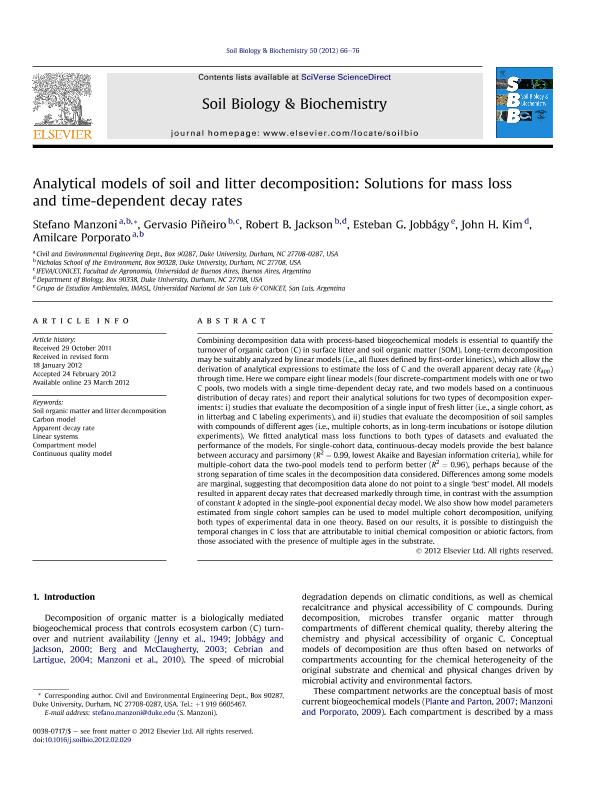Mostrar el registro sencillo del ítem
dc.contributor.author
Manzoni, Stefano

dc.contributor.author
Piñeiro, Gervasio

dc.contributor.author
Jackson, Robert B.

dc.contributor.author
Jobbagy Gampel, Esteban Gabriel

dc.contributor.author
Kim, John H.

dc.contributor.author
Porporato, Amilcare

dc.date.available
2017-05-23T19:44:44Z
dc.date.issued
2012-07
dc.identifier.citation
Manzoni, Stefano; Piñeiro, Gervasio; Jackson, Robert B.; Jobbagy Gampel, Esteban Gabriel; Kim, John H.; et al.; Analytical models of soil and litter decomposition: Solutions for mass loss and time-dependent decay rates; Elsevier; Soil Biology And Biochemistry; 50; 7-2012; 66-76
dc.identifier.issn
0038-0717
dc.identifier.uri
http://hdl.handle.net/11336/16889
dc.description.abstract
Combining decomposition data with process-based biogeochemical models is essential to quantify the turnover of organic carbon (C) in surface litter and soil organic matter (SOM). Long-term decomposition may be suitably analyzed by linear models (i.e., all fluxes defined by first-order kinetics), which allow the derivation of analytical expressions to estimate the loss of C and the overall apparent decay rate (kapp) through time. Here we compare eight linear models (four discrete-compartment models with one or two C pools, two models with a single time-dependent decay rate, and two models based on a continuous distribution of decay rates) and report their analytical solutions for two types of decomposition experiments: i) studies that evaluate the decomposition of a single input of fresh litter (i.e., a single cohort, as in litterbag and C labeling experiments), and ii) studies that evaluate the decomposition of soil samples with compounds of different ages (i.e., multiple cohorts, as in long-term incubations or isotope dilution experiments). We fitted analytical mass loss functions to both types of datasets and evaluated the performance of the models. For single-cohort data, continuous-decay models provide the best balance between accuracy and parsimony (R2 ¼ 0.99, lowest Akaike and Bayesian information criteria), while for multiple-cohort data the two-pool models tend to perform better (R2 ¼ 0.96), perhaps because of the strong separation of time scales in the decomposition data considered. Differences among some models are marginal, suggesting that decomposition data alone do not point to a single ‘best’ model. All models resulted in apparent decay rates that decreased markedly through time, in contrast with the assumption of constant k adopted in the single-pool exponential decay model. We also show how model parameters estimated from single cohort samples can be used to model multiple cohort decomposition, unifying both types of experimental data in one theory. Based on our results, it is possible to distinguish the temporal changes in C loss that are attributable to initial chemical composition or abiotic factors, from those associated with the presence of multiple ages in the substrate.
dc.format
application/pdf
dc.language.iso
eng
dc.publisher
Elsevier

dc.rights
info:eu-repo/semantics/openAccess
dc.rights.uri
https://creativecommons.org/licenses/by-nc-nd/2.5/ar/
dc.subject
Biogeochemistry
dc.subject
Organic Carbon
dc.subject
Decay Rate
dc.subject
Decomposition
dc.subject.classification
Ciencias Medioambientales

dc.subject.classification
Ciencias de la Tierra y relacionadas con el Medio Ambiente

dc.subject.classification
CIENCIAS NATURALES Y EXACTAS

dc.title
Analytical models of soil and litter decomposition: Solutions for mass loss and time-dependent decay rates
dc.type
info:eu-repo/semantics/article
dc.type
info:ar-repo/semantics/artículo
dc.type
info:eu-repo/semantics/publishedVersion
dc.date.updated
2017-05-22T20:49:02Z
dc.journal.volume
50
dc.journal.pagination
66-76
dc.journal.pais
Países Bajos

dc.journal.ciudad
Amsterdam
dc.description.fil
Fil: Manzoni, Stefano. University Of Duke. Nicholas School Of Environment; Estados Unidos
dc.description.fil
Fil: Piñeiro, Gervasio. University Of Duke. Nicholas School Of Environment; Estados Unidos. Consejo Nacional de Investigaciones Científicas y Técnicas. Oficina de Coordinación Administrativa Parque Centenario. Instituto de Investigaciones Fisiológicas y Ecológicas Vinculadas a la Agricultura. Universidad de Buenos Aires. Facultad de Agronomía. Instituto de Investigaciones Fisiológicas y Ecológicas Vinculadas a la Agricultura; Argentina
dc.description.fil
Fil: Jackson, Robert B.. University Of Duke. Nicholas School Of Environment; Estados Unidos
dc.description.fil
Fil: Jobbagy Gampel, Esteban Gabriel. Consejo Nacional de Investigaciones Científicas y Técnicas. Centro Científico Tecnológico Conicet - San Luis. Instituto de Matemática Aplicada de San Luis "Prof. Ezio Marchi". Universidad Nacional de San Luis. Facultad de Ciencias Físico, Matemáticas y Naturales. Instituto de Matemática Aplicada de San Luis ; Argentina
dc.description.fil
Fil: Kim, John H.. University Of Duke; Estados Unidos
dc.description.fil
Fil: Porporato, Amilcare. University Of Duke. Nicholas School Of Environment; Estados Unidos
dc.journal.title
Soil Biology And Biochemistry

dc.relation.alternativeid
info:eu-repo/semantics/altIdentifier/doi/http://dx.doi.org/10.1016/j.soilbio.2012.02.029
dc.relation.alternativeid
info:eu-repo/semantics/altIdentifier/url/http://www.sciencedirect.com/science/article/pii/S0038071712000946
Archivos asociados
